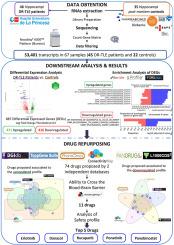“转录组分析揭示了耐药性颞叶癫痫的新治疗选择”。
IF 4.7
3区 医学
Q1 PHARMACOLOGY & PHARMACY
引用次数: 0
摘要
背景:25-30%的癫痫患者药物治疗失败,导致耐药性。颞叶癫痫是与耐药性相关的最常见亚型。经典药物的发现是一个漫长而昂贵的过程,在临床试验中失败率很高。药物再利用是一种更具成本效益和时间效益的策略。因此,本研究的主要目的是通过基于转录组学分析的药物重组,提出治疗耐药颞叶癫痫(DR-TLE)的候选药物。方法:对DR-TLE患者45个福尔马林固定石蜡包埋(FFPE)海马和死后生物库供体36个FFPE海马进行总rna测序(RNA-Seq)。RNA-Seq在Illumina NovaSeq 6000平台上进行,对端为100bp。基于转录组学分析对这些数据库进行药物再利用:Pandrugs2, PharmOmics, DGIdb, ToppGene, L1000CDS2和Connectivity Map。结果:我们鉴定出887个基因在DR-TLE患者和死后对照组之间存在差异表达。我们在至少两个独立的数据库中观察到74种潜在的候选药物。其中,我们只选择了11种可以穿过血脑屏障的药物:cobimetinib、panobinostat、melphalan、rucaparib、alectinib、ponatinib、danazol、carboplatin、vandetanib、erlotinib和ge非替尼。在分析了它们调节癫痫发生的机制、安全性和有效性后,我们列出了前5名候选药物。结论:基于差异RNA-Seq分析,我们推荐厄洛替尼、达那唑、鲁卡帕尼、波纳替尼和帕比诺司他。本文章由计算机程序翻译,如有差异,请以英文原文为准。

Transcriptomic profiling unveils novel therapeutic options for drug-resistant temporal lobe epilepsy
Background
Epilepsy drug treatments fail in 25–30 % of patients, leading to drug resistance. Temporal lobe epilepsy is the most prevalent subtype associated with drug resistance. Classical drug discovery is a long and extremely costly process with a high failure rate in clinical trials. Drug repurposing is a more cost- and time-effective strategy. Hence, the main objective of this study is to propose drug candidates for the treatment of drug-resistant temporal lobe epilepsy (DR-TLE) through drug repurposing based on transcriptomic profiling.
Methods
Total RNA-sequencing (RNA-Seq) was performed on 45 formalin-fixed paraffin-embedded (FFPE) hippocampi of DR-TLE patients and 36 FFPE hippocampi of post-mortem biobank donors. RNA-Seq was carried out on an Illumina NovaSeq 6000 platform in 100bp paired-end. Drug repurposing based on transcriptomic analysis top candidates was performed against these databases: Pandrugs2, PharmOmics, DGIdb, ToppGene, L1000CDS2 and Connectivity Map.
Results
We identified 887 genes differentially expressed between DR-TLE patients and post-mortem controls. We observed 74 potential drug candidates in at least two independent databases. Of these, we selected only the 11 which can cross the blood-brain barrier: cobimetinib, panobinostat, melphalan, rucaparib, alectinib, ponatinib, danazol, carboplatin, vandetanib, erlotinib, and gefitinib. After analyzing their mechanisms to modulate epileptogenesis, their safety and efficacy profiles from previous publications, we provide a list of the top 5 candidates.
Conclusion
Based on differential RNA-Seq profiling, we therefore propose erlotinib, danazol, rucaparib, ponatinib, and panobinostat.
求助全文
通过发布文献求助,成功后即可免费获取论文全文。
去求助
来源期刊
CiteScore
9.00
自引率
0.00%
发文量
572
审稿时长
34 days
期刊介绍:
The European Journal of Pharmacology publishes research papers covering all aspects of experimental pharmacology with focus on the mechanism of action of structurally identified compounds affecting biological systems.
The scope includes:
Behavioural pharmacology
Neuropharmacology and analgesia
Cardiovascular pharmacology
Pulmonary, gastrointestinal and urogenital pharmacology
Endocrine pharmacology
Immunopharmacology and inflammation
Molecular and cellular pharmacology
Regenerative pharmacology
Biologicals and biotherapeutics
Translational pharmacology
Nutriceutical pharmacology.

 求助内容:
求助内容: 应助结果提醒方式:
应助结果提醒方式:


